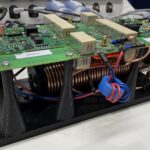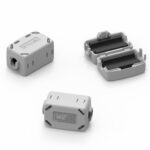Frenetic Electronics announced Frenetic Factory, a worldwide magnetics production facility with plants in the USA, Mexico, Europe, India, and China. Frenetic Factory can deliver samples quickly with no MOQs. It currently has a production capacity of 8.75M units annually, which can be scaled to even higher volumes fast. Frenetic launched its magnetics design service in […]
Magnetics
APEC 2024: Semiconductors, modules, transformers, and chargers
Power supplies from phone chargers to EVs to industrial machinery rely on semiconductors, either in discrete packages or integrated into power modules, to deliver power. APEC 2024 was full of power sources and components. The roundup below highlights regulators, switches, and power semiconductors. We also highlight wireless power delivery and chargers. Be sure to see […]
Magnetic shielding line now includes sheets with high permeability for NFC applications
TDK Corporation extends its Flexield family of magnetic shielding materials with the introduction of the IFQ06, offering high permeability (μ’) and low magnetic loss (μ”) designed for near-field communications (NFC) applications. The IFQ06 material provides highly effective protection against performance-reducing design features that can complicate NFC designs, such as metal objects directly behind the antenna. […]
What are the six kinds of magnetism?
Diamagnetism, paramagnetism, ferromagnetism, ferrimagnetism, antiferromagnetism, and superparamagnetism are the six kinds of magnetism. This FAQ begins with a brief review of the basic sources of magnetism, considers the magnetic susceptibility of various materials, and then briefly presents the characteristics of the six types of magnetism. The root cause of magnetism is the behavior of electrons, […]
What are the types of magnets and how can they contribute to sustainability?
There are multiple types of magnets, including temporary magnets, permanent magnets, and electromagnets. Each type of magnet has a variety of uses and can contribute to a more sustainable society. This FAQ reviews the basics of each type of magnet, looks at what it can be used for, presents some efforts to develop sustainable permanent […]
How do magnetic poles, fields, flux, and domains work?
Magnetics is a key technology for sustainable power conversion, electric vehicle motors, motion sensing and control in various medical, industrial, and consumer applications, and advanced data storage technologies. Advances in magnetics often provide the foundation for advances in electronic technologies and devices. This FAQ presents the basics of magnetic field lines and field strength, looks […]
What’s the difference between hard and soft magnetic materials?
These distinctions refer specifically to ferromagnetic and ferrimagnetic materials, not just hard and soft materials. There are super-soft, very-soft, soft, semi-hard, and hard magnetic material classifications based on the magnetic coercivity (HC) measured in ampere/meter (A/m) units or Oersteds (Oe). This FAQ is focused primarily on soft, semi-hard, and hard magnetic materials. It begins with […]
Magnetic components carry automotive certifications
Automotive electronics are subjected to special requirements. This has resulted in industry-typical standards such as AEC-Q200 qualification or IATF-16949-certified production. In this context, Würth Elektronik has supplemented its extensive catalog for automotive components. Highlights among the new additions include WE-CAR-TEC and WE-CNSA. The WE-CAR-TEC series is a folding ferrite with a core material made of NiZn. […]
Transformers for ultrasonic sensing applications
Ultrasonic sensing is used in various automotive and industrial applications ranging from liquid level sensing to robot obstacle detection and automated parking assistance. Transformer-based designs can produce highly accurate solutions with maximum ranging distances. This FAQ will review several applications for ultrasonic sensing, compare the capabilities of transformer drive with direct drive solutions, and then […]
Magnetics for Power over Ethernet
Power-over-Ethernet (PoE) delivers power to remote powered devices (PDs) over twisted-pair Ethernet cables up to 100 meters long. Over time, the standard has evolved and can now deliver up to 71W, making it useful for a wide variety of applications, including network routers and repeaters, VoIP phones, IP security cameras, wireless and Bluetooth access points, […]











